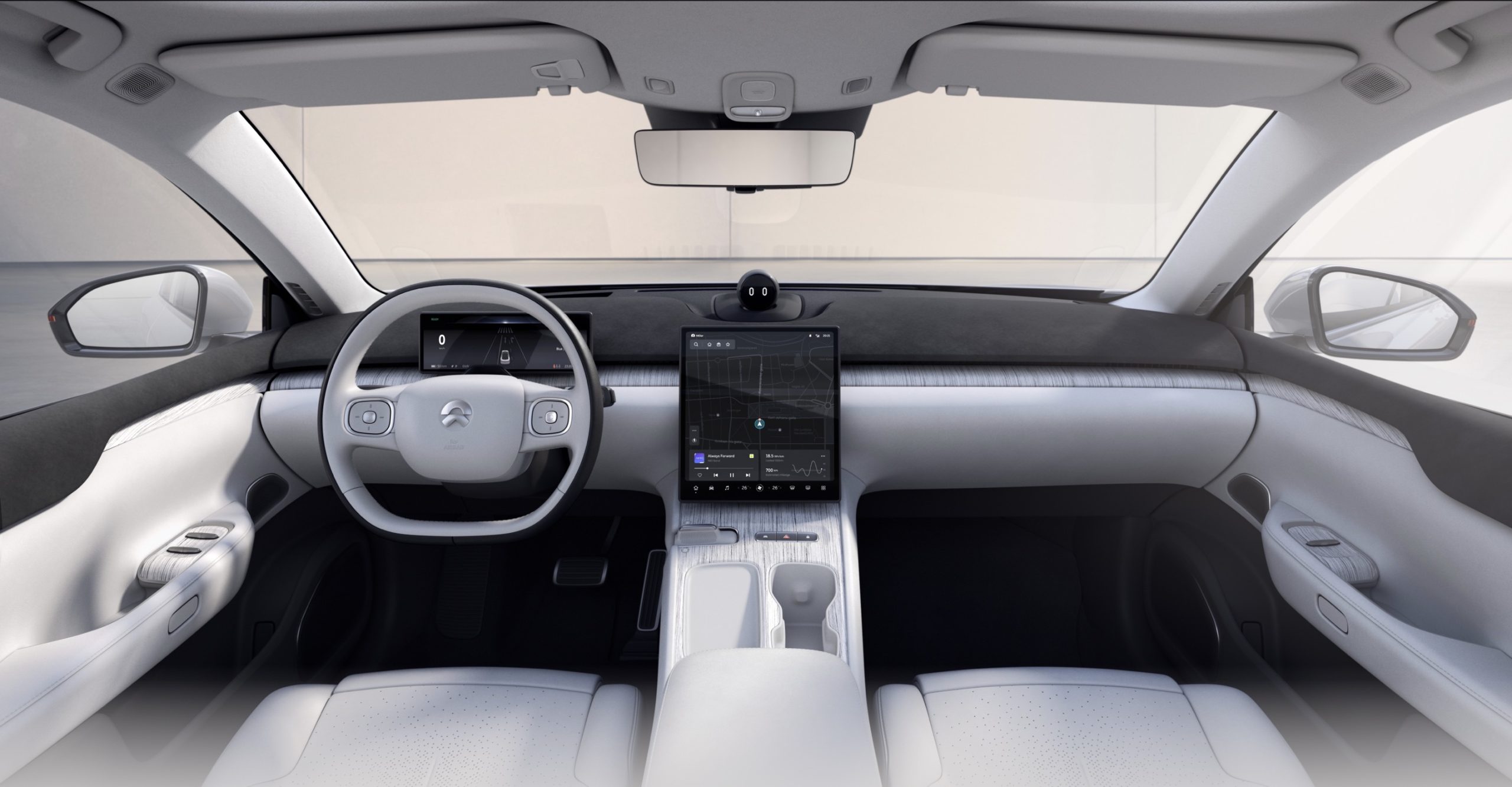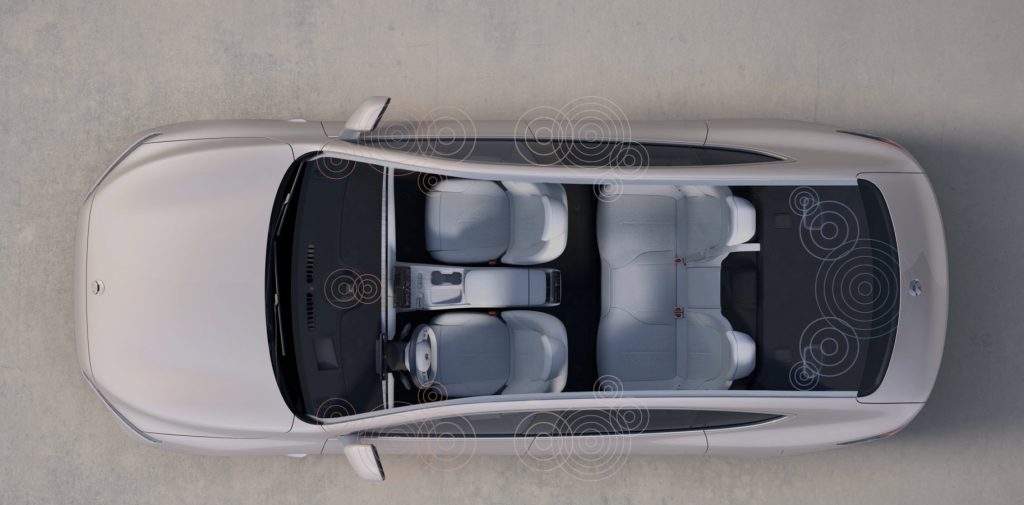

News
NIO ET7 audio system reveals how important software will be in future vehicles [Editorial]
NIO went the extra mile—and then some—when it conceptualized the audio system for the ET7. The NIO ET7 has 23 speakers powered by Swedish digital audio pioneer Dirac’s Opteo Professional audio software and Dolby Atmos technology.
NIO and Dirac’s work on the ET7’s audio system reveals the changing design of the car’s cabin and the role software plays in its redesign.
The NIO ET7’s Sound
Every automaker has a specific sound they would like their passengers to enjoy in their vehicles. NIO also has a particular sound target, and for the ET7, the Chinese automaker wanted it to come through crystal clear.
NIO worked closely with Dirac to create its sound. The NIO ET7’s official online page states that the four-seater car has 23 speakers, four overhead speakers, and a subwoofer. It also has a 20-channel amplifier and comes standard with Dolby Atmos Technology.
NIO didn’t just add lots of speakers to the ET7, though. The China-based automaker together with Dirac were meticulous and intentional with the ET7’s audio system.
Redefining the Cabin
Audio experts must consider the environment the sound will be played in, making it challenging to work with vehicles. Lars Carlsson, the Head of Business Development Automotive Audio and Vice President at Dirac, told Teslarati that audio experts have to consider many things when creating the perfect sound inside a vehicle. They have to consider the number and position of the speakers and the number of seats in the vehicle. Audio experts must also consider how sound reflects on the cabin’s different surfaces and windows.
Each speaker output in the NIO ET7 was measured with 16 microphones, positioned in each seat for a total of 64 measurement positions in the cabin. The measured data gave Dirac a good overview of the acoustic performance of the car’s cabin and creates the base for Dirac’s patented algorithms to optimize the sound.
“We base everything on measurements and data. Our process really saves audio engineers a lot of time. They can tune on their computer instead of spending weeks in the car,” Carlsson said.
After measuring the cabin, Dirac used algorithms to “derive the optimum solution” for its sound field control technology. With sound field control, Dirac created “super speakers” for the ET7. Typically, there are three speakers in a car door: low frequency, mid-range frequency, and a tweeter for the high frequency. Dirac uses sound field control to digitally align the speakers, making them collaborate to realize one full, quality sound.
“In addition our algorithm lets the speakers in the cabin and the subwoofer collaborate to create an even sound field in the car, which means we can actually create an equal audio experience in every seat. You get the voice right in front of you and a good imaging and a very even bass distribution and tight bass,” explained Carlsson.

Software’s Critical Role in Future Vehicles
Software is playing an increasingly important role in the auto industry as automotive OEMs and startups reconceptualize the idea of the vehicle. Now, automakers are reimagining the use of the car cabin as more vehicles integrate autonomous software.
Software lies at the center of redesigning the cabin space for passenger activities. Many automakers have started investing in software for their vehicles. For instance, Volkswagen invested €2 billion in a joint venture with China-based Horizon Robotics. And Stellantis launched a software development center in India recently.
Audio, in particular, is beginning to play a more significant role in the cabin as automakers introduce more types of media for passengers to enjoy while on the road. Electric cars coming out on the market have fun new features now, like karaoke, videos, games, and more which rely heavily on audio systems. However, it is autonomy that drives the cabin’s redesign.
“We have an enormous interest for our solutions because audio is getting more and more important in the car. This is true for electric cars because it’s a quieter environment but also when looking into autonomous cars, where maybe you’ll be working in your car, you’ll be listening to music, you’ll be watching videos, you’ll have maybe rotating seats,” said Carlsson.
“There’s a lot of challenges also coming ahead, but I would say that Dirac is very well equipped for future challenges because software for anything in the cars is key,” he added.
The Teslarati team would appreciate hearing from you. If you have any tips, contact me at maria@teslarati.com or via Twitter @Writer_01001101.

Elon Musk
Tesla’s Elon Musk: 10 billion miles needed for safe Unsupervised FSD
As per the CEO, roughly 10 billion miles of training data are required due to reality’s “super long tail of complexity.”

Tesla CEO Elon Musk has provided an updated estimate for the training data needed to achieve truly safe unsupervised Full Self-Driving (FSD).
As per the CEO, roughly 10 billion miles of training data are required due to reality’s “super long tail of complexity.”
10 billion miles of training data
Musk comment came as a reply to Apple and Rivian alum Paul Beisel, who posted an analysis on X about the gap between tech demonstrations and real-world products. In his post, Beisel highlighted Tesla’s data-driven lead in autonomy, and he also argued that it would not be easy for rivals to become a legitimate competitor to FSD quickly.
“The notion that someone can ‘catch up’ to this problem primarily through simulation and limited on-road exposure strikes me as deeply naive. This is not a demo problem. It is a scale, data, and iteration problem— and Tesla is already far, far down that road while others are just getting started,” Beisel wrote.
Musk responded to Beisel’s post, stating that “Roughly 10 billion miles of training data is needed to achieve safe unsupervised self-driving. Reality has a super long tail of complexity.” This is quite interesting considering that in his Master Plan Part Deux, Elon Musk estimated that worldwide regulatory approval for autonomous driving would require around 6 billion miles.
FSD’s total training miles
As 2025 came to a close, Tesla community members observed that FSD was already nearing 7 billion miles driven, with over 2.5 billion miles being from inner city roads. The 7-billion-mile mark was passed just a few days later. This suggests that Tesla is likely the company today with the most training data for its autonomous driving program.
The difficulties of achieving autonomy were referenced by Elon Musk recently, when he commented on Nvidia’s Alpamayo program. As per Musk, “they will find that it’s easy to get to 99% and then super hard to solve the long tail of the distribution.” These sentiments were echoed by Tesla VP for AI software Ashok Elluswamy, who also noted on X that “the long tail is sooo long, that most people can’t grasp it.”
News
Tesla earns top honors at MotorTrend’s SDV Innovator Awards
MotorTrend’s SDV Awards were presented during CES 2026 in Las Vegas.

Tesla emerged as one of the most recognized automakers at MotorTrend’s 2026 Software-Defined Vehicle (SDV) Innovator Awards.
As could be seen in a press release from the publication, two key Tesla employees were honored for their work on AI, autonomy, and vehicle software. MotorTrend’s SDV Awards were presented during CES 2026 in Las Vegas.
Tesla leaders and engineers recognized
The fourth annual SDV Innovator Awards celebrate pioneers and experts who are pushing the automotive industry deeper into software-driven development. Among the most notable honorees for this year was Ashok Elluswamy, Tesla’s Vice President of AI Software, who received a Pioneer Award for his role in advancing artificial intelligence and autonomy across the company’s vehicle lineup.
Tesla also secured recognition in the Expert category, with Lawson Fulton, a staff Autopilot machine learning engineer, honored for his contributions to Tesla’s driver-assistance and autonomous systems.
Tesla’s software-first strategy
While automakers like General Motors, Ford, and Rivian also received recognition, Tesla’s multiple awards stood out given the company’s outsized role in popularizing software-defined vehicles over the past decade. From frequent OTA updates to its data-driven approach to autonomy, Tesla has consistently treated vehicles as evolving software platforms rather than static products.
This has made Tesla’s vehicles very unique in their respective sectors, as they are arguably the only cars that objectively get better over time. This is especially true for vehicles that are loaded with the company’s Full Self-Driving system, which are getting progressively more intelligent and autonomous over time. The majority of Tesla’s updates to its vehicles are free as well, which is very much appreciated by customers worldwide.
Elon Musk
Judge clears path for Elon Musk’s OpenAI lawsuit to go before a jury
The decision maintains Musk’s claims that OpenAI’s shift toward a for-profit structure violated early assurances made to him as a co-founder.

A U.S. judge has ruled that Elon Musk’s lawsuit accusing OpenAI of abandoning its founding nonprofit mission can proceed to a jury trial.
The decision maintains Musk’s claims that OpenAI’s shift toward a for-profit structure violated early assurances made to him as a co-founder. These claims are directly opposed by OpenAI.
Judge says disputed facts warrant a trial
At a hearing in Oakland, U.S. District Judge Yvonne Gonzalez Rogers stated that there was “plenty of evidence” suggesting that OpenAI leaders had promised that the organization’s original nonprofit structure would be maintained. She ruled that those disputed facts should be evaluated by a jury at a trial in March rather than decided by the court at this stage, as noted in a Reuters report.
Musk helped co-found OpenAI in 2015 but left the organization in 2018. In his lawsuit, he argued that he contributed roughly $38 million, or about 60% of OpenAI’s early funding, based on assurances that the company would remain a nonprofit dedicated to the public benefit. He is seeking unspecified monetary damages tied to what he describes as “ill-gotten gains.”
OpenAI, however, has repeatedly rejected Musk’s allegations. The company has stated that Musk’s claims were baseless and part of a pattern of harassment.
Rivalries and Microsoft ties
The case unfolds against the backdrop of intensifying competition in generative artificial intelligence. Musk now runs xAI, whose Grok chatbot competes directly with OpenAI’s flagship ChatGPT. OpenAI has argued that Musk is a frustrated commercial rival who is simply attempting to slow down a market leader.
The lawsuit also names Microsoft as a defendant, citing its multibillion-dollar partnerships with OpenAI. Microsoft has urged the court to dismiss the claims against it, arguing there is no evidence it aided or abetted any alleged misconduct. Lawyers for OpenAI have also pushed for the case to be thrown out, claiming that Musk failed to show sufficient factual basis for claims such as fraud and breach of contract.
Judge Gonzalez Rogers, however, declined to end the case at this stage, noting that a jury would also need to consider whether Musk filed the lawsuit within the applicable statute of limitations. Still, the dispute between Elon Musk and OpenAI is now headed for a high-profile jury trial in the coming months.








